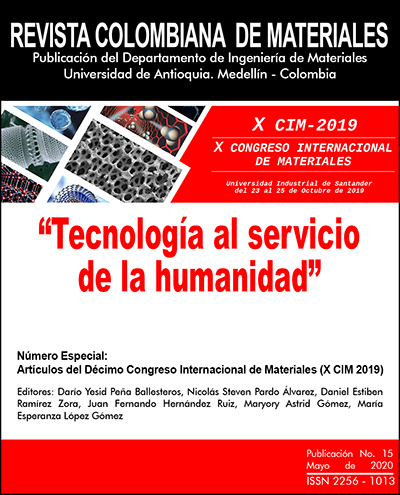Propuesta metodológica para la construcción y ensamble de un prototipo de chasis Go Kart bajo la norma CIK/FIA utilizando uniones hibridas
DOI:
https://doi.org/10.17533/udea.rcm.342069Palavras-chave:
uniones híbridas, diseño de junta adhesiva, chasis go kart, norma CIK/FIAResumo
Se propuso un procedimiento para la construcción y ensamble de un chasis tubular tomando como referencia un chasis de un vehículo monoplaza go kart, utilizando uniones adhesivas anaeróbicas como alternativa de ensamble. La metodología consistió en establecer cinco etapas que incluyen desde el diseño de la unión hasta el ensamble. La etapa uno de definición, radica en estudiar el comportamiento estructural del chasis sometido a cargas estáticas mediante análisis por elementos finitos, para conocer los esfuerzos a los cuales está sometido cada nodo, identificando y caracterizando los puntos del chasis donde se utilizará adhesivo. Las etapas dos y tres, medición y diseño proponen el diseño óptimo de la junta adhesiva cilíndrica a solape simple. Teniendo en cuenta en su diseño los parámetros geométricos de la junta y propiedades del material de la unión (duraluminio). En la etapa de corte y doblado se construyen todos los elementos del chasis, se diseña una matriz de soldadura para garantizar así que el chasis cumpla con la norma CIK/FIA y las solicitaciones mecánicas. Para el ensamble se inicia con los puntos con adhesivo y luego los soldados, las uniones con adhesivo se curan a una temperatura entre los 80°C y 100°C por 1 hora. Los resultados de este trabajo mostraron que la flexión y la torsión son los esfuerzos críticos que estos chasis deben soportar, además en el ensamble de uniones soldadas se debe mantener las juntas cubiertas para no aumentar su temperatura y causar fallas en la unión adhesiva.
Downloads
Referências
Ledezma, R., Diseño Y Comportamiento De Uniones Estructurales Mecánicas y Adhesivas. Condiciones Superficiales Y Operacionales, Tesis de Ing., Escuela Técnica Superior de Ingenieros Industriales, Madrid, 2013.
Taheri, F., Hosseinzadeh, R., “Non-linear investigation of overlap length effect on torsional capacity of tubular adhesively bonded joints”, In: Composite Structures, Volumen 91, no. 2, 186-195, 2009.
García, G. L., Influencia Del Acabado Superficial Sobre La Resistencia De Juntas Adhesivas Para Fijación De Elementos Cilíndricos. Tesis de Maestría, Universidad Nacional de Colombia, Medellín, Colombia, 2006.
Gil, L. F., Influencia De Parámetros Geométricos Sobre El Comportamiento Mecánico De Juntas Adhesivas Anaeróbicas Sometidas A Ensayos Destructivos De Torsión Pura. Tesis de Maestría, Universidad Nacional de Colombia, Medellín, Colombia, 2015.
Gil, L. F., García, G. L., Espinosa, A., “Correlación de parámetros geométricos para evaluar la resistencia mecánica de juntas adhesivas anaeróbicas sometidas a ensayos de torsión pura,” In: VII Congreso Internacional de Materiales, Número 5, Medellín, Colombia, 2013.
Quezada, P. A., Diseño Y Fabricación Del Chasis Para Un Kart KF Según La Norma CIK/FIA. Tesis de pregrado, Universidad Politécnica Salesiana, Cuenca, Ecuador, 2018.
CIK/FIA. RÈGLEMENT TECHNIQUE DE KARTING, [Online], Available: http://www.cikfia.com/regulations/technical.html, [Accessed: 3-May-2019].
LOCTITE 648 HOJA DE DATOS TÉCNICOS, [Online], Available: http://www.edifik.com.co/wp-content/uploads/2015/08/1835920_ficha.pdf, [Accessed: 28-Jun- 2019].
Anadón, R., Pabón, D., Diseño De Un Kart De pista. Tesis final de grado, Universidad Politécnica de Cataluña, Barcelona, España, 2012.
Méndez, C. A., Alvares, C., Fernández. Y.B., et al., “Comportamiento estático y modal del chasis de un ómnibus modernizado,” In: Ingeniería Mecánica, Volumen. 16, no 2. , 161-170, 2013.
Parra, J., Ríos, R., “Estudio del comportamiento bajo carga de un chasis para transporte de pasajeros por medio de la tecnología de elementos finitos en la empresa equitel cumandes S.A.” In: Avances Investigación En Ingeniería, no. 6, 103-109. ISSN 1794-4953, 2006.
Downloads
Publicado
Como Citar
Edição
Seção
Licença
Copyright (c) 2020 Revista Colombiana de Materiales

Este trabalho está licenciado sob uma licença Creative Commons Attribution-NonCommercial-ShareAlike 4.0 International License.








